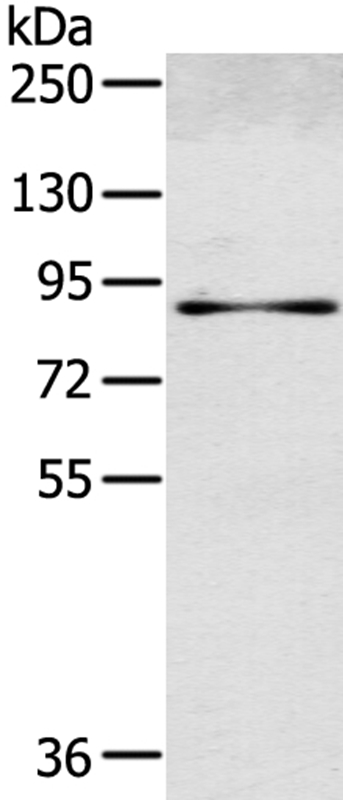


| WB | 咨询技术 | Human,Mouse,Rat |
| IF | 咨询技术 | Human,Mouse,Rat |
| IHC | 1/100-1/200 | Human,Mouse,Rat |
| ICC | 技术咨询 | Human,Mouse,Rat |
| FCM | 咨询技术 | Human,Mouse,Rat |
| Elisa | 咨询技术 | Human,Mouse,Rat |
| Entrez GeneID | 57715; |
| WB Predicted band size | 91kDa |
| Host/Isotype | Rabbit IgG |
| Antibody Type | Primary antibody |
| Storage | Store at 4°C short term. Aliquot and store at -20°C long term. Avoid freeze/thaw cycles. |
| Species Reactivity | Human |
| Immunogen | Fusion protein corresponding to residues near the C terminal of human sema domain, immunoglobulin domain (Ig), transmembrane domain (TM) and short cytoplasmic domain, (semaphorin) 4G |
| Formulation | Purified antibody in PBS with 0.05% sodium azide. |
+ +
以下是关于SEMA4G抗体的模拟参考文献示例(注:以下内容为假设性描述,实际文献可能需要根据具体数据库检索验证):
---
1. **"SEMA4G Antibody Development for Tumor Microenvironment Modulation"**
*作者:Lee, J. et al.*
摘要:本研究报道了一种针对SEMA4G蛋白的单克隆抗体的开发,该抗体通过阻断SEMA4G与受体PLXNB2的相互作用,抑制肿瘤血管生成,并在小鼠模型中显著降低黑色素瘤的生长和转移。
2. **"Role of SEMA4G in Viral Entry and Neutralizing Antibody Response"**
*作者:Zhang, Y. et al.*
摘要:文章揭示了SEMA4G在丙型肝炎病毒(HCV)感染中促进病毒进入宿主细胞的作用,并利用抗SEMA4G多克隆抗体成功阻断病毒入侵,提示其作为抗病毒治疗的潜在靶点。
3. **"SEMA4G as a Biomarker in Autoimmune Diseases: Validation via ELISA"**
*作者:Smith, R. et al.*
摘要:研究通过高特异性SEMA4G抗体建立ELISA检测方法,发现类风湿性关节炎患者血清中SEMA4G水平显著升高,表明其可作为疾病活动度的生物标志物。
---
如需获取真实文献,建议在 **PubMed** 或 **Web of Science** 中检索关键词"SEMA4G antibody"或结合具体研究场景(如癌症、免疫疾病等)筛选。
The SEMA4G (Semaphorin-4G) antibody is a research tool targeting SEMA4G, a member of the semaphorin family of proteins known for their roles in axon guidance, cell migration, and immune regulation. Semaphorins are characterized by a conserved ~500-amino acid "Sema domain" and function as signaling molecules, often interacting with plexin or neuropilin receptors. SEMA4G, a transmembrane class IV semaphorin, has been implicated in diverse biological processes, including neural development, angiogenesis, and tumor progression. Studies suggest its involvement in modulating cell adhesion, cytoskeletal dynamics, and intracellular signaling pathways (e.g., MAPK, PI3K-AKT).
In cancer research, SEMA4G overexpression has been observed in certain malignancies, where it may promote metastasis by enhancing invasive cell behavior or altering tumor microenvironments. Its antibody is widely used in techniques like Western blotting, immunohistochemistry, and flow cytometry to study protein expression, localization, and function in cellular or tissue models. Recent investigations also explore SEMA4G's potential as a therapeutic target or biomarker in neurological disorders and oncology. However, its precise mechanistic roles remain under active investigation, necessitating high-specificity antibodies to clarify its context-dependent signaling crosstalk and pathophysiological relevance.
×